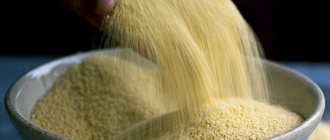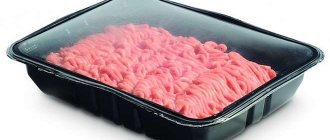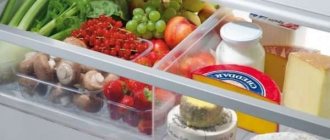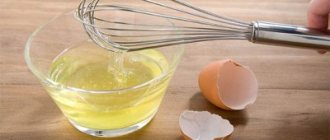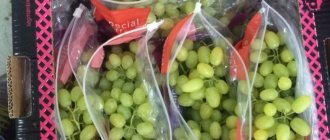Cabbage is harvested in the fall, stored and used for several months. In winter, sauerkraut will delight you with its crunch and vitamins if it is properly prepared and stored without loss of quality.
Pickles are stored in barrels, glass jars, which are placed in the basement, cellar or refrigerator. We will tell you in the article how long sauerkraut can be stored in the refrigerator, what conditions must be observed and what product should not be eaten.
Storing sauerkraut in the refrigerator
The shelf life of the products depends on several factors : ambient temperature and humidity, selected container, additional ingredients.
If you follow the storage conditions, the pickles will last for 6-8 months in the refrigerator .
In an open container, the product is stored in the refrigerator for no more than two months . But experienced housewives extend the shelf life using their secrets.
Selection of containers
The choice of container for fermentation is important ; the shelf life depends on it:
- Enameled pan or bucket . The inner surface is checked for chips to prevent metal oxidation. Store exclusively covered and under pressure for about 6 months.
- Glass jars . The easiest way to store them is in the refrigerator, always under an airtight lid, completely covered with brine. The shelf life will be about 4-6 months.
- Plastic containers . Storage in the refrigerator will be no more than 2-3 weeks. It is allowed to freeze in small portions and then immediately use the defrosted product for food.
Temperature
The main factor influencing shelf life is temperature . Sauerkraut is a product obtained by natural fermentation, which means that in the heat it can become acidic and become inedible.
Interesting things on the site:
The best sauerkraut recipes without salt and sugar
How to pickle cabbage for the winter using quartered heads of cabbage
If you maintain a temperature of +5...+8°C , then the workpiece retains its beneficial properties for 2-3 weeks.
Experienced housewives advise storing the salted vegetable at a temperature from 0 to +4°C , then you can enjoy the crispy taste of cabbage for up to 8 months.
Humidity
Do not allow dry air in the place where the workpiece is stored . Optimal humidity is 85-95%.
Brine quantity
Proper preparation significantly affects shelf life. It is important to ensure that the brine covers the layer of cabbage . If the chopped vegetable is exposed in the container, then salt is dissolved in cooled boiled water and added to the top of the workpiece. And to prevent this from happening, they put pressure on sauerkraut.
Attention! If the top layer has darkened, it means that the pickle has become unfit for consumption.
Use of preservatives
Extend the shelf life of the product using preservatives . Suitable for this:
- Granulated sugar . It is sprinkled on top of the cabbage from time to time.
- Acetic acid . Add just a little bit so as not to spoil the natural taste of the fermented vegetable.
- Vegetable oil . Oil is poured over the top of the workpiece so that it forms a thin film. It will not allow oxygen to pass through and will stop the fermentation process.
- Salt . Sometimes cabbage is specially salted so that it can be stored longer. But such a product is not suitable for use in salads.
- Cranberry . Benzoic acid contained in berries inhibits the development of bacteria and gives a special taste and aroma to the product.
Can it be frozen?
Sauerkraut is often frozen. At the same time, its shelf life increases significantly. In this state, she is able to “hold out” for more than eight months.
The defrosted product is somewhat inferior in taste, but retains most of its beneficial properties . After thawing, the product must be stored according to standard rules (at low positive temperatures).
The vegetable cannot be re-frozen, since in this case not only a large amount of biologically active substances is lost, but also the organoleptic properties noticeably deteriorate.
How to tell if cabbage has gone bad
A spoiled product can be seen by several signs:
- Smell . If you smell an unpleasant smell of a rotten product.
- An intense fermentation process began at the top of the container in the form of bubbles, foam or even mold. All this indicates a violation of the ripening process.
- Brine turbidity . When cabbage is salted, liquid is released. Ideally, the brine has a transparent color throughout storage. If it begins to become cloudy, it means the product has begun to deteriorate.
You can try a suspicious pickling by taking a small amount. Although cabbage is called “sour”, the taste of a spoiled vegetable is easy to determine.
Where to store
Dishes
For long-term preservation of cabbage stored for the winter, wooden barrels, which have long been used by our ancestors, are ideal. In modern conditions (especially in apartments in city houses) it is not entirely convenient to use them.
As an option, enamel containers of suitable volume (bucket or large pan) are used.
Important! When choosing them, you need to carefully examine the container for chips and damage to the enamel. If they are present, the dishes should be rejected.
At home, the product can also be stored in three-liter glass jars, which are always available to a thrifty housewife. Plastic or aluminum containers cannot be used for these purposes. When exposed to acid, the metal immediately oxidizes, which is why its taste is felt in the product.
After choosing the dishes, you should figure out the specific place where the cabbage will be kept.
Is it possible on the balcony
When choosing the optimal location for placing containers of sauerkraut, many immediately think of the outdoor spaces (balconies) found in almost any apartment. The conditions in them are quite suitable for a long stay of the product, so the preparations directly in the jars can be transferred there without any problems.
Additional information: It is recommended to cover them with an old warm blanket if the temperature outside the window drops below 10 degrees.
It’s not at all difficult to answer the question of whether and how to store cabbage snacks in a bucket on a balcony or loggia. This option is no different from the cases already considered (taking into account protection from severe frosts). The most important thing is that the bucket is enameled.
Also read: How to properly store honey at home
Other storage options
Often in the fall the refrigerator cannot accommodate all the supplies. Then the jars, buckets and pans are sent to cellars, basements, etc.
Storage in a cellar or basement
The cellar allows you to store preserved food in barrels . Oak barrels preserve the taste of the product, and suitable conditions of temperature and air humidity will preserve the preparations for as long as possible - up to 8 months.
Balcony
Recently, plastic windows have often been installed on balconies, insulated and maintained at a comfortable temperature in winter. On such balconies, cabbage is stored in jars or enamel containers.
If the balcony is cold, then the container with salted vegetables is frozen . When necessary, the top layer is loosened, the required amount of product is collected, and warmed at room temperature. The rest is left frozen.
Choosing a container
In order for the workpiece to be stored for a long time, it is not enough to maintain the correct temperature . It is also important to choose the right container.
Plastic containers
Proper plastic containers must meet safety standards and be intended for storing and freezing food products.
Melamine containers are not suitable for storing workpieces - they are usually not marked and are very toxic. PP, or PP, marking is applied to the safest plastic. It is used to make bottles for feeding children and containers for storing food.
PS, or PS, is also suitable for containers, but such containers should not be heated.
Containers with markings are completely suitable for storing workpieces:
- PET, PETE, or PET;
- HDPE, or HDPE;
- OTHER, or Other.
It is strictly forbidden to use containers marked V or PVC or PVC . This is technical toxic plastic. You should not freeze the product in boxes marked LDPE, or MDV.
Useful tips
When considering how best to preserve the especially valuable substances of sauerkraut, it is important to pay attention to its structure. The coarse fibers contained in it stimulate the processes of digestion and metabolism in the human body. In addition, even after canning, it retains especially valuable vitamin C, which is necessary for people to maintain immunity.
In order for all these properties to remain in the product throughout the entire storage period, you must adhere to the following recommendations and tips:
- Cabbage preparations should be completely covered with brine.
- If there is a lack of liquid, a pressure (a heavy object such as a dumbbell or brick) is placed on the lid, ensuring compression of the mass and the release of the brine to the outside.
- Adding a small amount of sugar to the surface of the starter will help protect cold appetizers from harmful microorganisms (it is a good preservative).
- For this purpose, vinegar is sometimes used, added to the brine in very minute quantities.
- Vegetable oil also helps preserve cabbage fermented for the winter. When adding it, it is important to ensure that it completely covers the entire product and blocks the access of oxygen.
- Adding more salt to the cabbage than usual will also help preserve it for a longer period of time.
In the latter case, the taste of the fermented product is slightly different from the usual, so it is more suitable for preparing hot dishes and soups.
Vegetable selection
The correct choice of cabbage depends on the quality of the original product:
- only late and mid-late varieties will be suitable for further processing;
- the vegetable must be cleaned of dirt, green leaves, and weighed;
- the head should be tight, dense without visible damage from diseases and pests;
- the stalk should be cut level with the head of cabbage, and the green leaves should be washed and prepared to cover the top layer of chopped vegetables;
- only cabbage is suitable for processing; when cut, it will have a snow-white-cream color without visible damage to the middle and stalk by rot and fungi;
- prepared cabbage should be processed within 24 hours.
The benefits of this workpiece
Cabbage itself is an incredibly healthy vegetable.
It contains a lot of calcium, zinc, magnesium, iron, potassium and phosphorus. In addition to all this, it is rich in various amino acids, which are very important for the human body. What's so special about this salad? Interesting: Storing Pumpkins for the Winter in the Freezer
First of all, it replenishes vitamin deficiencies in winter, which improves immunity. Among other things, the vegetable prepared in this way contains the following vitamins:
- U – has a beneficial effect on the stomach and intestines, preventing the formation of ulcers;
- C – responsible for immunity;
- B – accelerates metabolic processes.
